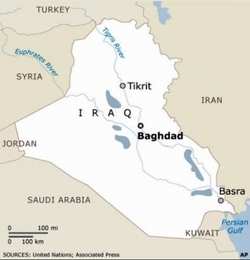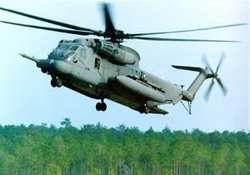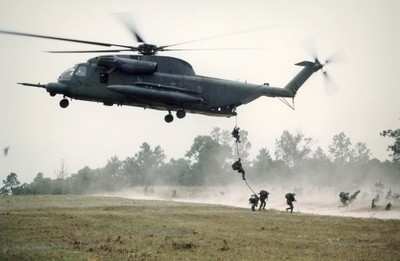"The Best Job I Ever Worked My Tail Off For"
 (Editor's Note:
Aero-News thanks Linda D. Kozaryn, American Forces Press Service,
for the following report. ANN would also like to take this
opportunity on this, the 231st year of independence for the United
States, to thank all those serving in harm's way overseas. The
entire country is in your debt.)
(Editor's Note:
Aero-News thanks Linda D. Kozaryn, American Forces Press Service,
for the following report. ANN would also like to take this
opportunity on this, the 231st year of independence for the United
States, to thank all those serving in harm's way overseas. The
entire country is in your debt.)
Despite being shot down over Iraq and nearly losing an eye, Air
Force Tech Sgt. Christian MacKenzie remains committed to the Air
Force and his love of flying.
For nearly 10 years, life was good for MacKenzie. He'd found his
dream job as a special operations flight engineer aboard an MH-53
Pave Low helicopter, flying low-level, long-range, undetected
flights into enemy territory, day or night, in all kinds of
weather, to insert, extract and resupply special operations
forces.
After graduating as a flight engineer in 1994, MacKenzie flew
missions in South Korea, Bosnia and Croatia, and took part in
exercises in Qatar and Bahrain. He flew combat missions over Kosovo
during Operation Allied Force and over the southern Iraq no-fly
zone during Operation Southern Watch.
"Being a Pave Low flight engineer was the best job I ever worked
my tail off for," he told American Forces Press Service during a
recent interview.
The 38-year-old non-commissioned officer racked up 2,300 hours
of flight time, including 500 hours in combat. He served in a
combat zone every year since 1996.

"You didn't see us in the news," he said. "There were no parades
or big flag-waving ceremonies or anything like that. We went in. We
did our job. We did what our country needed us to do.
"You could see the smiles on the guys' faces -- we never knew
their names. We pulled them out and they went about their
business," he said. "At the end of the day, that's what it was all
about. Without somebody patting you on the back, taking your
picture or shaking your hand, the job itself rewarded you for doing
those kinds of missions."
Rough Flying in Afghanistan and Iraq
 When duty with the 20th Special
Operations Squadron called MacKenzie to Afghanistan, he said, the
country's rough terrain presented some major challenges. "It was
the toughest flying I ever did," he recalled. "You were flying at
the aerodynamic edge of your aircraft in a way that there was no
room for error."
When duty with the 20th Special
Operations Squadron called MacKenzie to Afghanistan, he said, the
country's rough terrain presented some major challenges. "It was
the toughest flying I ever did," he recalled. "You were flying at
the aerodynamic edge of your aircraft in a way that there was no
room for error."
The crew had to calculate fuel and the weight of personnel, he
said, along with the distances, altitudes, the harsh terrain,
unpredictable winds and the number of people they had to take in.
On some missions, the Pave Low, which burns 3,000 pounds of fuel an
hour, would get down to 300 to 400 pounds of fuel.
"It was down to the wire," he said. "We would actually go up to
altitude to dump off fuel to trim our weight down to get in, and
then we'd get down there and the sand dunes would have moved or the
(landing zone) would have changed. We'd only have enough gas to
make one, maybe two attempts at it.
"We really didn't have a lot of options," he said. "Our noise
signature and the people we were working with, everything had to be
on time, on target. There was not a lot of room for error"
Because they flew at night, he said, people often shot at the
noise even though they couldn't see the helicopter.
"One night, a team of 11 guys had been compromised in
Afghanistan. By the time we launched, it had been an hour and a
half since anybody had talked to them. We were going on their last
set of coordinates. By the time two ships got in there, pulled them
out and got back home, we'd been engaged by enemy fire 23 different
times."

In 2003, MacKenzie deployed to Kuwait, where he began flying
mainly resupply missions into Iraq. Daylight flights, heat and
sandstorms became part of his routine.
"We'd go out for a six- to eight-hour mission and practically
have to get an IV bag to get rehydrated when we got back, even when
we were drinking water the whole time," he recalled. "The
temperature would be around 120 to 130, and we'd be loading cargo,
bringing supplies and equipment."
From Kuwait, MacKenzie's next rotation took him into Iraq, which
had become increasingly more dangerous. During one mission from
Baghdad to Fallujah, fate delivered a nearly fatal blow that
changed the course of MacKenzie's life.
 Entering the Fallujah Hot Zone
On April 13, 2004, MacKenzie's Pave Low went on a night mission to
deliver supplies to a team in Fallujah, a desert city crawling with
armed insurgents.
Entering the Fallujah Hot Zone
On April 13, 2004, MacKenzie's Pave Low went on a night mission to
deliver supplies to a team in Fallujah, a desert city crawling with
armed insurgents.
"US Marines were moving in. People were getting beheaded. You
did not stop there. You either flew around Fallujah or you flew
across in certain areas. It was in and out. There was no messing
around. There were rockets. There were so many enemies that just
wanted to shoot anything in the air," he said.
From Fallujah, they were to pick up the remains of a team
sergeant major who had been killed in Mahmadiyah, a town south of
Baghdad. MacKenzie's Pave Low, however, never made it that far.
"We were about 180 feet off the ground, when an insurgent stood
up about 300 feet in front of us and fired an RPG straight into the
nose of the helicopter," MacKenzie said. "It blew about a four-foot
hole in the helicopter. It hit right in front of me."
Luckily, MacKenzie said, he was looking down working the
navigation system when the rocket came in.
"It broke my face in three places and tore my eyeball apart. I
had flash burns from the explosion, shrapnel all up and down my
arms and superficial burns. I couldn't hear. I couldn't see. I had
no sense of touch, no sense of smell."
Air Force Capt. Tom Lessner, the co-pilot on his right, lost
control of the helicopter. "It blew his helmet off his head,"
MacKenzie recalled. "He lost his night vision goggles. It peeled
the roof back over our head, so we had no throttles, no way of
controlling the engines.
"After we got hit, a second RPG went right
between us and the second helicopter behind us," MacKenzie said.
"They said we went 80 degrees nose up and then started falling out
of the sky."
 Air Force Capt. Steve
Edwards, the pilot on MacKenzie's left, with wounds to his arm, the
side of his face and his leg, "was able to maintain his night
vision goggles and regain control of the helicopter." On the
ground, with about 45 insurgents in the field, a second Pave Low
came in to rescue the downed aircrew.
Air Force Capt. Steve
Edwards, the pilot on MacKenzie's left, with wounds to his arm, the
side of his face and his leg, "was able to maintain his night
vision goggles and regain control of the helicopter." On the
ground, with about 45 insurgents in the field, a second Pave Low
came in to rescue the downed aircrew.
MacKenzie was rushed to a nearby medical unit in Baghdad before
being flown to Landstuhl Regional Medical Center in Germany. "When
they took off the bandages a day and a half later, I had 20-400
vision, blood in my eyes and corneal abrasions," he said.
"I talked to my wife when I was on the table in the recovery
room from Baghdad, and I apologized to her, because I was more
concerned about what she was going through at that moment than me.
I was just happy to be alive," he said.
From Landstuhl, MacKenzie moved to Wilford Hall Medical Center
at Lackland Air Force Base, Texas. "This is where the battles began
to become real. I was trying to save my bad eye, trying to save my
face," he said. "My goal was to fly again."
Since his boyhood in New England, MacKenzie had always wanted to
fly. He had planned to join the military after high school, but
love led him to his future wife, Jennifer. She and his baby
daughter changed his plans.
Knowing he still longed for the open skies,
Jennifer encouraged him to reach for his boyhood dream. In 1991, he
earned his wings with the Air Force.
 "I guess deep down inside, I
just wanted to do something for my country," he recalled. "I wanted
to make a difference. There's more to the world than just hanging
around home, and I knew that the only way I could fly was in the
service of my country."
"I guess deep down inside, I
just wanted to do something for my country," he recalled. "I wanted
to make a difference. There's more to the world than just hanging
around home, and I knew that the only way I could fly was in the
service of my country."
For most career airmen, losing the vision in an eye signals the
end of military service. Though MacKenzie's eye was damaged, he was
determined to fly again.
All 'Jacked Up' But Still Alive
MacKenzie learned quickly that to recover from the serious
battle wounds, he would have to overcome physical and mental
anguish.
"Every day, when you go through something like that, you have to
make a decision, 'Do I get out of bed or do I just stay here?'" he
said. "I'd wake up and think, 'I'm in pain. Things hurt. I didn't
sleep well. I can't sleep the way I want to. I can't do the things
I want to. I can't even pick up more than a half gallon of milk.
What am I doing? I'm never going to fly again.' All that negative
stuff runs through your head."
But every day he got up, knowing that was the first step to
getting back to the life he loved. He told himself, "OK, I'm all
jacked up, but I'm alive, so the rest is trivial."
MacKenzie's will to fly again remained undaunted throughout his
recovery.
"Pretty much everybody said, 'No way,'" he noted. "From the
beginning they said, 'Your left eye is too damaged. We really need
to just remove it. I said, 'No, you don't. Work at fixing it and if
it fails after all you can do, then I'll let you take it out."
The doctors went to work, performing seven surgeries on his eyes
and two surgeries on his face.
"Right now, I can see lights and shadows," MacKenzie said. "They
finally got my retina to stay attached and maintain its own
pressure. I can see movement. It's still my eye. I can see
perfectly with my other eye."

In July 2005, a medical board approved MacKenzie's request to
remain on active duty. In August, he was returned to flying status
and reassigned to Andrews Air Force Base to work as a flight
attendant, which is a far cry from being a special operations
flight engineer flying clandestine chopper missions.
But MacKenzie said he doesn't mind.
"That was just a phase of life. In an instant, it was over," he
said. "I don't compare this job to my last job. They're two
completely different worlds. This is a new phase and I still get to
fly.
"I think I'm the only 'one-eyed' flying guy in the Air Force,"
he said with a smile.
 ANN's Daily Aero-Linx (04.15.24)
ANN's Daily Aero-Linx (04.15.24) Classic Aero-TV: 'No Other Options' -- The Israeli Air Force's Danny Shapira
Classic Aero-TV: 'No Other Options' -- The Israeli Air Force's Danny Shapira Aero-News: Quote of the Day (04.15.24)
Aero-News: Quote of the Day (04.15.24) Airborne 04.16.24: RV Update, Affordable Flying Expo, Diamond Lil
Airborne 04.16.24: RV Update, Affordable Flying Expo, Diamond Lil ANN's Daily Aero-Term (04.16.24): Chart Supplement US
ANN's Daily Aero-Term (04.16.24): Chart Supplement US










